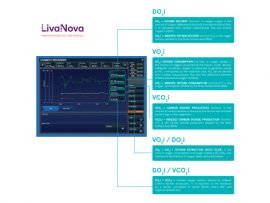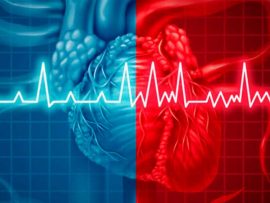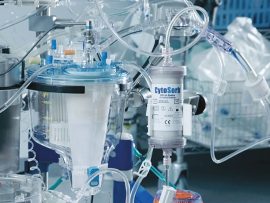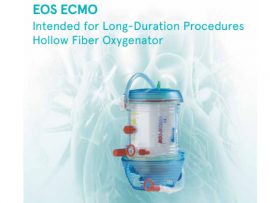Abstract Management of fluids has progressively moved towarda more dynamic and functional approach based on theprediction of fluid responsiveness (FR), to improve effi-cacy and benefits and limit detrimental effects of..
Read MoreAbstract Heparins have been invaluable therapeutic anticoagulant polysaccharides for over a century, whether used as unfractionated heparin or as low molecular weight heparin (LMWH) derivatives. However, heparin production by extraction..
Read MoreAbstract Background: Thrombosis within extracorporeal membrane oxygenation (ECMO) circuits is a common complication that dominates clinical management of patients receiving mechanical circulatory support. Prior studies have identified that over 80%..
Read MoreAbstract OBJECTIVES To compare the independent and combined effects of anaemia and red blood cell transfusion on late survival after isolated coronary artery bypass grafting. METHODS Retrospective analysis of 5243..
Read MoreAbstract Objectives: Depression has been associated with increased cardiovascular morbidity and mortality. This study aimed to determine whether self-reported preoperative depressive symptoms were associated with worse long-term survival in patients undergoing..
Read MoreAbstract Background Sleep disturbance is highly prevalent among post-operative cardiac patients, with negative impacts on surgical recovery and rehabilitation. Post-operative pain and anxiety commonly seen in cardiac surgery patients are..
Read MoreAbstract Implementation science is a nascent field that aims to study the factors that influence the effectiveness of a given clinical intervention, such as the characteristics of the individuals involved,..
Read MoreAbstract Current shock guidelines recommend norepinephrine as the first-line vasopressor to increase mean arterial pressure (MAP) and eventually restore tissue perfusion []. Norepinephrine (or noradrenaline) is an endogenous catecholamine, produced..
Read MoreAbstract Objective The effects of stroke and delirium on postdischarge cognition and patient-centered health outcomes after surgical aortic valve replacement (SAVR) are not well characterized. Here, we assess the impact..
Read MoreAbstract Goal: Microbubbles (MBs) are known to occur within the circuits of cardiopulmonary bypass (CPB) systems, and higher-order dysfunction after cardiac surgery may be caused by MBs as well as..
Read MoreAbstract Common for major surgery, multitrauma, sepsis, and critical illness, is a whole-body inflammation. Tissue injury is able to trigger a generalized inflammatory reaction. Cell death causes release of endogenous..
Read MoreAbstract Purpose: Goal-directed perfusion (GDP) refers to individualized goal-directed therapy using comprehensive monitoring and optimizing the delivery of oxygen during cardiopulmonary bypass (CPB). This study aims to determine whether the intraoperative..
Read MoreAbstract Introduction Evidence suggests that Extracorporeal Cardiopulmonary Resuscitation (ECPR) can improve survival rates for nontraumatic out-of-hospital cardiac arrest (OHCA). However, when ECPR is indicated over 50% of potential candidates are..
Read MoreAbstract Despite immediate coronary revascularization, mortality of patients experiencing infarct-related cardiogenic shock (AMICS) remains high [1]. Over the past decade, there has been a growing interest in the use of..
Read MoreAbstract Background Extracorporeal membrane oxygenation (ECMO) is a rescue therapy in patients with severe acute res‑piratory distress syndrome (ARDS) secondary to COVID‑19. While bleeding and thrombosis complicate ECMO, theseevents may..
Read MoreAbstract Objective: To investigate the correlation between the amount of sufentanil used during anesthesia and intraoperative hemodynamic fluctuation and postoperative recovery in patients undergoing cardiopulmonary bypass (CPB). Materials and Methods: A retrospective..
Read MoreAbstract We tested whether the brain and kidney respond differently to cardiopulmonary bypass (CPB) and to changes in perfusion conditions during CPB. Therefore, in ovine CPB, we assessed regional cerebral..
Read MoreAbstract Intraoperative antithrombotic drug removal by haemoadsorption is a novel strategy to reduce perioperative bleeding in patients on antithrombotic drugs undergoing cardiac surgery. The international STAR registry reports real-world clinical..
Read MoreAbstract Mortality in infarct-related as well as heart failure-associated cardiogenic shock remains high, reaching 40–50% depending on the etiology and severity of cardiogenic shock. Percutaneous active mechanical circulatory support devices..
Read MoreAbstract Extracorporeal membrane oxygenation (ECMO) is a form of cardiorespiratory support, and is being increasingly used to support refractory heart and respiratory failure. It involves draining blood from the vascular..
Read MoreAbstract Molecular oxygen is typically delivered to patients via oxygen inhalation or extracorporeal membrane oxygenation (ECMO), potentially resulting in systemic hyperoxia from liberal oxygen inhalation or localized hyperoxia in the..
Read MoreAbstract Background Cardiac surgery–associated (AKI) is associated with increased postoperative morbidity and mortality. Evidence suggests an association between perioperative administration and decreased incidence of postoperative AKI in cardiac surgery patients; however, an effect..
Read MoreAbstract Background The use of extracorporeal membrane oxygenation (ECMO) for patients with acute respiratory distress syndrome (ARDS) has increased substantially. With modern trials supporting its efficacy, ECMO has become an..
Read MoreAbstract Cardiac surgery (CS) with extracorporeal circulation (ECC), induces intense oxidative stress (OS) and systemic inflammatory response (SIR), which may seriously affect postoperative lung function. We aimed to test if..
Read MoreAbstract Background: Cardiogenic shock in children still carries a high mortality risk despite advances in medical therapy. The use of temporary mechanical circulatory supports is an accepted strategy to bridge patients..
Read MoreAbstract Extracorporeal Cardiopulmonary Resuscitation (ECPR) has potential benefits compared to conventional Cardiopulmonary Resuscitation (CCPR) in children. Although no randomised trials for paediatric ECPR have been conducted, there is extensive literature..
Read MoreAbstract Objective Enhanced recovery after cardiac surgery is a multidisciplinary clinical that relies on a bundle of interventions, aiming to reduce the stress response to surgery and promote early recovery of..
Read MoreAbstract Weaning and liberation from VA ECMO in cardiogenic shock patients comprises a complex process requiring a continuous trade off between multiple clinical parameters. In the absence of dedicated international..
Read MoreAbstract Background and purpose Current information on the latest rehabilitative practices is limited, with previous reviews only covering data up to October 2021, and some considering only patients on awake..
Read MoreAbstract Objectives To investigate the effect of retrograde autologous priming (RAP) on coagulation function using rotation thromboelastometry (ROTEM) in patients undergoing valvular cardiac surgery. Design A prospective, randomized, patient- and outcome assessor-blinded study...
Read More






















